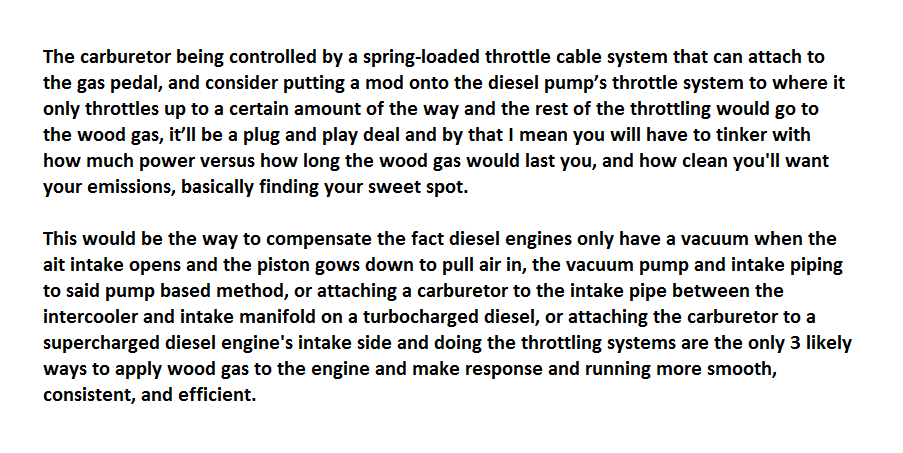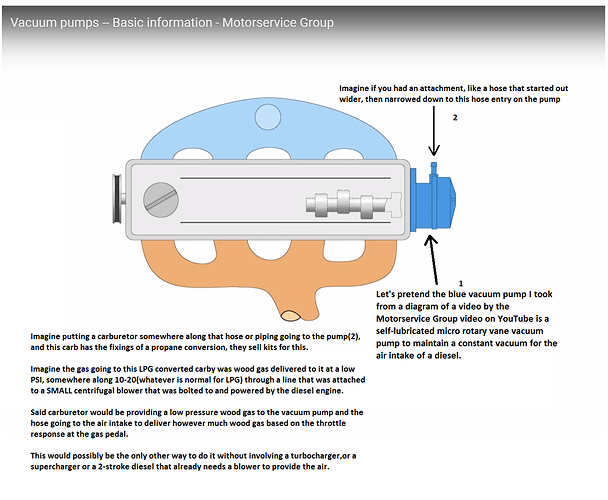Couple possibilities to add here.
In general I think it may make the most sense to just run a diesel on heavy oil, or maybe convert it to spark ignition for straight woodgas…
BUT check out these links
https://www.chemeng.lth.se/exjobb/E487.pdf
(those two are open access, would love to get access to the full papers in these other links)
If these HCCI engines can successfully run on hot tar laden woodgas would that not be a large improvement?? In addition to getting rid of the condensers/scrubbers (past what’s needed to filter particulates), seems like it could free up the gasifier design to use styles that make higher tar gas but may have other advantages… and if you’re not familiar with HCCI tech, they commonly preheat the intake stream to over 100*C even when using various more conventional fuels. They are also exceptionally tolerant of very dilute/low energy fuels, while still able to run at higher efficiency than most SI engines and with enough tuning can surpass small diesels in that regard too. While producing no soot and little NOx.
If the gas remains hot all the way to the engine, wouldn’t a supercharger or electric blower between the gasifier and engine be able to provide the suction for safe gasification and easy woodgas:air ratio control? It could be arranged to suck air thru a throttle valve into the woodgas before the blower or a second blower could handle the engine air needs. If you were worried about tar accumulating where the cold air blends with the hot raw woodgas then just preheat the air enough to keep final mix sufficiently hot, even 160-180C may be enough once its diluted with air. Providing some boost pressure to the engine intake should offset the lower density of a warm gas mix if desired. If you’re worried about flashback of woodgas air mixture, which would be reasonable hahaha adding a flame arrestor shouldn’t be that hard, in addition to the obvious mixing the woodgas and air as close as possible to the intake.
I know a lot of this may not be so useful for folks focused on mobile applications, because from what I can tell controlling an HCCI to run right over a wide power range with transients is still quite difficult and best left to the big auto companies and those DIYers with very high level instrumentation/automation skills (and budgets)… but if you mostly need a small unit to charge batteries, run grow lights, cogen, direct drive a heat pump, irrigate, etc it seems at least somewhat feasible.
Personally, I’m contemplating what it would take to convert a 10kw ChangFa watercooled S195 into an experimental HCCI engine to play with running it on hot high tar gases. I don’t remember where i saw it now, but I found an abstract that stated they found no real influence of tar content on HCCI operation over their tested range of 2-16g/cubic meter and I suspect it could handle more. But there’s a lot of variables involved here so who knows till they try it. I do know the mean effective pressures and cylinder pressure rise rates of all the research HCCI engines I’ve read about are less than half what ole ChangFa is designed for and it would hopefully be operating at well below design RPM to make best use of low flame speed of diluted woodgas so there appears to be a bit of room for trial and error, unless I’m missing something? Parts from china are cheap if it does break… Even if its derated down to a usable shaft output of 2-3kw in HCCI mode I wouldn’t be disappointed, I doubt I’d need more than a couple kw in the foreseeable future anyway. Still quite a few details to work out with this project tho,
And with all this talk of mods to reduce compression for a diesel to spark conversion, has anyone considered using exhaust gas recirc instead? It appears to work well to delay the autoignition in an HCCI that’s sucking hot gas, seems like it would work in an SI arrangement too. AFIAK adding water spray could also accomplish a similar retarding effect, if your climate is warm enough to not freeze the lines or you plumb it to handle freezing and remelt as the engine warms up.




